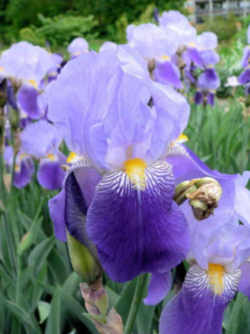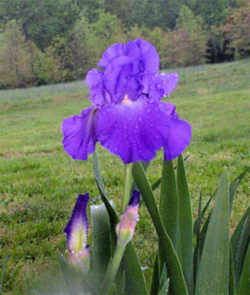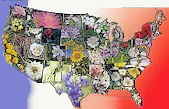
Tennessee Symbols
Tennessee State Cultivated Flower
Iris

(genus Iris L.)
Adopted in 1933; 1973 Redesignated.
See also Tennessee State Wild Flower
The iris, (genus Iris L.,) was designated as Tennessee state cultivated flower by the Legislature in 1933. While there are several different colors among the iris, the purple iris is commonly accepted as the state flower.
In 1919, the General Assembly, by Senate Joint Resolution 13, provided that a state flower be chosen by the school children of Tennessee. Accordingly, a vote was taken and the passion flower was chosen. The January 26, 1919 issue of the Nashville Banner listed some of their favorites: the daisy, red clover, rose, water lily, elder bloom, goldenrod, wild rose, sunflower, and violet. The eventual winner, the passion flower, wasn't even mentioned! Although the passion flower was adopted as Tennessee's state flower in 1919, Tennessean's loyalty shifted. Nashville, Tennessee became known as the Iris City. Iris fans joined forces and campaigned for the adoption of the iris as the Tennessee State flower. In 1933, however, the Legislature adopted Senate Joint Resolution 53 designating the iris as the "State Flower of Tennessee," but failed to formally rescind the designation of the passion flower as the state flower. To eliminate this confusion, in 1973 the 88th General Assembly, by Chapter 16, designated the passion flower the state wildflower and the iris the state cultivated flower.
Tennessee State Culivated Flower: Iris

The iris, genus Iris, is an herbaceous perennial of which there are about 170 species, including several North American varieties, the most common of which is the Blue Flag. While there are several different colors among the iris, and the act naming the iris as the state flower did not name a particular color, by common acceptance the purple iris is considered the state flower.
The iris family is closely related to the lily and amaryllis families, differing from them in having three stamens rather than six. The cultivated irises (genus Iris ), freesias (genus Freesia ), and gladioli (genus Gladiolus ) show a wide variety of colors in their large, usually perfumed blossoms; they are mostly hybrids of Old World species. The many species of wild iris are most common in temperate and sub arctic regions of North America, where they are often called flags, or blue flags.
The iris flower belongs to the natural order Iridaceae of the class Monocotyledons, which is characterized by a petaloid six-parted perianth, an
inferior ovary and only three stamens (the outer series), being thus distinguished from the Amaryllidaceae family, which has six stamens. They are
handsome showy-flowered plants, the Greek name having been applied on account of the hues of the flowers. True irises (the genus Iris, containing more
than 200 species) grow from thick underground stems called rhizomes. Admired for their beauty since very ancient times, irises were nevertheless cultivated
by the ancient Egyptians primarily for these rhizomes, which were used as a source of medicine and perfumes, a practice brought to Europe by the Greeks
and continued until the early part of the 20th century.
Rhizomatous irises are divided into three groups - the bearded, the crested, and the beardless. The designation "bearded" derives from the
fuzzy caterpillar-like appendage that runs down the center of each of the flower's three drooping outer segments, or falls; the three inner, more upright,
segments are called standards
Characteristics of the Iris
- Height x width: 4"-48" depending on species
- Growth rate: moderate to fast
- Foliage: narrow, generally linear to lanceolate, sheathing base, parallel-veined, mostly basal in fans or from bulb center
- Flowers: generally 1-6 on stalks above leaves; 3 outer flower segments (falls) often drooping downwards (reflexed), sometimes with a central "beard"
of colored hairs or ridge, often with a patch of different color (signal); 3 inner flower segments (standards) often upright and narrow in some species;
standards and falls may be different colors, most colors available
- Hardiness: zones 3 to 6 - 8 to 9
The Tennessee Code
The law designating the iris as the official Tennessee state cultivated flower is found in the Tennessee Code, Title 4, Chapter 1, Part 3, Section 4-1-307.
TITLE 4. STATE GOVERNMENT.
CHAPTER 1. GENERAL PROVISIONS.
PART 3. STATE SYMBOLS.
SECTION 4-1-307.
4-1-307. State cultivated flower.
The iris, family iridaceae, is designated as the state cultivated flower.
[Acts 1973, ch. 16, § 2; T.C.A., § 4-118.]
Taxonomic Hierarchy: Iris
Kingdom: Plantae - Plants
Subkingdom: Tracheobionta - Vascular plants
Superdivision: Spermatophyta - Seed plants
Division: Magnoliophyta - Flowering plants
Class: Liliopsida - Monocotyledons
Subclass: Liliidae -
Order: Liliales -
Family: Iridaceae - Iris family
Genus: Iris L. - iris
State Floral Emblems







